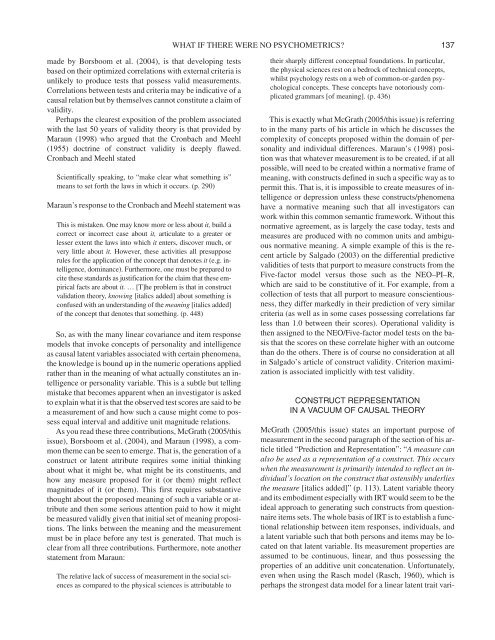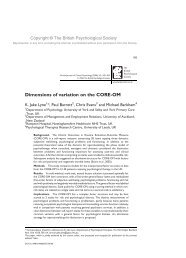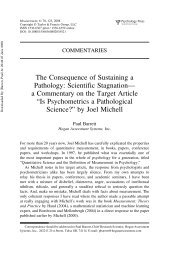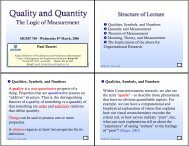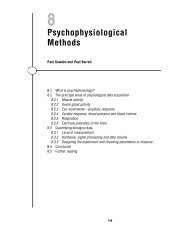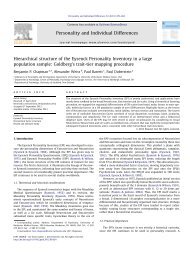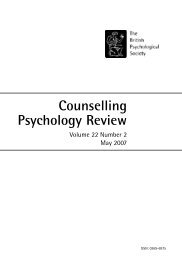What If There Were No Psychometrics?: Constructs ... - Paul Barrett
What If There Were No Psychometrics?: Constructs ... - Paul Barrett
What If There Were No Psychometrics?: Constructs ... - Paul Barrett
Create successful ePaper yourself
Turn your PDF publications into a flip-book with our unique Google optimized e-Paper software.
made by Borsboom et al. (2004), is that developing tests<br />
based on their optimized correlations with external criteria is<br />
unlikely to produce tests that possess valid measurements.<br />
Correlations between tests and criteria may be indicative of a<br />
causal relation but by themselves cannot constitute a claim of<br />
validity.<br />
Perhaps the clearest exposition of the problem associated<br />
with the last 50 years of validity theory is that provided by<br />
Maraun (1998) who argued that the Cronbach and Meehl<br />
(1955) doctrine of construct validity is deeply flawed.<br />
Cronbach and Meehl stated<br />
Scientifically speaking, to “make clear what something is”<br />
means to set forth the laws in which it occurs. (p. 290)<br />
Maraun’s response to the Cronbach and Meehl statement was<br />
This is mistaken. One may know more or less about it, build a<br />
correct or incorrect case about it, articulate to a greater or<br />
lesser extent the laws into which it enters, discover much, or<br />
very little about it. However, these activities all presuppose<br />
rules for the application of the concept that denotes it (e.g. intelligence,<br />
dominance). Furthermore, one must be prepared to<br />
cite these standards as justification for the claim that these empirical<br />
facts are about it. … [T]he problem is that in construct<br />
validation theory, knowing [italics added] about something is<br />
confused with an understanding of the meaning [italics added]<br />
of the concept that denotes that something. (p. 448)<br />
So, as with the many linear covariance and item response<br />
models that invoke concepts of personality and intelligence<br />
as causal latent variables associated with certain phenomena,<br />
the knowledge is bound up in the numeric operations applied<br />
rather than in the meaning of what actually constitutes an intelligence<br />
or personality variable. This is a subtle but telling<br />
mistake that becomes apparent when an investigator is asked<br />
to explain what it is that the observed test scores are said to be<br />
a measurement of and how such a cause might come to possess<br />
equal interval and additive unit magnitude relations.<br />
As you read these three contributions, McGrath (2005/this<br />
issue), Borsboom et al. (2004), and Maraun (1998), a common<br />
theme can be seen to emerge. That is, the generation of a<br />
construct or latent attribute requires some initial thinking<br />
about what it might be, what might be its constituents, and<br />
how any measure proposed for it (or them) might reflect<br />
magnitudes of it (or them). This first requires substantive<br />
thought about the proposed meaning of such a variable or attribute<br />
and then some serious attention paid to how it might<br />
be measured validly given that initial set of meaning propositions.<br />
The links between the meaning and the measurement<br />
must be in place before any test is generated. That much is<br />
clear from all three contributions. Furthermore, note another<br />
statement from Maraun:<br />
The relative lack of success of measurement in the social sciences<br />
as compared to the physical sciences is attributable to<br />
WHAT IF THERE WERE NO PSYCHOMETRICS? 137<br />
their sharply different conceptual foundations. In particular,<br />
the physical sciences rest on a bedrock of technical concepts,<br />
whilst psychology rests on a web of common-or-garden psychological<br />
concepts. These concepts have notoriously complicated<br />
grammars [of meaning]. (p. 436)<br />
This is exactly what McGrath (2005/this issue) is referring<br />
to in the many parts of his article in which he discusses the<br />
complexity of concepts proposed within the domain of personality<br />
and individual differences. Maraun’s (1998) position<br />
was that whatever measurement is to be created, if at all<br />
possible, will need to be created within a normative frame of<br />
meaning, with constructs defined in such a specific way as to<br />
permit this. That is, it is impossible to create measures of intelligence<br />
or depression unless these constructs/phenomena<br />
have a normative meaning such that all investigators can<br />
work within this common semantic framework. Without this<br />
normative agreement, as is largely the case today, tests and<br />
measures are produced with no common units and ambiguous<br />
normative meaning. A simple example of this is the recent<br />
article by Salgado (2003) on the differential predictive<br />
validities of tests that purport to measure constructs from the<br />
Five-factor model versus those such as the NEO–PI–R,<br />
which are said to be constitutive of it. For example, from a<br />
collection of tests that all purport to measure conscientiousness,<br />
they differ markedly in their prediction of very similar<br />
criteria (as well as in some cases possessing correlations far<br />
less than 1.0 between their scores). Operational validity is<br />
then assigned to the NEO/Five-factor model tests on the basis<br />
that the scores on these correlate higher with an outcome<br />
than do the others. <strong>There</strong> is of course no consideration at all<br />
in Salgado’s article of construct validity. Criterion maximization<br />
is associated implicitly with test validity.<br />
CONSTRUCT REPRESENTATION<br />
IN A VACUUM OF CAUSAL THEORY<br />
McGrath (2005/this issue) states an important purpose of<br />
measurement in the second paragraph of the section of his article<br />
titled “Prediction and Representation”: “A measure can<br />
also be used as a representation of a construct. This occurs<br />
when the measurement is primarily intended to reflect an individual’s<br />
location on the construct that ostensibly underlies<br />
the measure [italics added]” (p. 113). Latent variable theory<br />
and its embodiment especially with IRT would seem to be the<br />
ideal approach to generating such constructs from questionnaire<br />
items sets. The whole basis of IRT is to establish a functional<br />
relationship between item responses, individuals, and<br />
a latent variable such that both persons and items may be located<br />
on that latent variable. Its measurement properties are<br />
assumed to be continuous, linear, and thus possessing the<br />
properties of an additive unit concatenation. Unfortunately,<br />
even when using the Rasch model (Rasch, 1960), which is<br />
perhaps the strongest data model for a linear latent trait vari-


